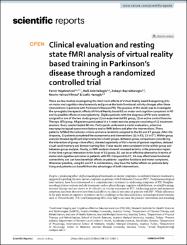| dc.contributor.author | Hajebrahimi, Farzin | |
| dc.contributor.author | Velioğlu, Halil Aziz | |
| dc.contributor.author | Bayraktaroğlu, Zübeyir | |
| dc.contributor.author | Helvacı Yılmaz, Nesrin | |
| dc.contributor.author | Hanoğlu, Lütfü | |
| dc.date.accessioned | 2022-06-16T06:53:21Z | |
| dc.date.available | 2022-06-16T06:53:21Z | |
| dc.date.issued | 2022 | en_US |
| dc.identifier.citation | Hajebrahimi, F., Velioğlu, H. A., Bayraktaroğlu, Z., Helvacı Yılmaz, N. ve Hanoğlu, L. (2022). Clinical evaluation and resting state fMRI analysis of virtual reality based training in Parkinson's disease through a randomized controlled trial. Scientific Reports, 12(1). https://doi.org/10.1038/s41598-022-12061-3 | en_US |
| dc.identifier.issn | 2045-2322 | |
| dc.identifier.uri | https://doi.org/10.1038/s41598-022-12061-3 | |
| dc.identifier.uri | https://hdl.handle.net/20.500.12511/9522 | |
| dc.description.abstract | There are few studies investigating the short-term effects of Virtual Reality based Exergaming (EG) on motor and cognition simultaneously and pursue the brain functional activity changes after these interventions in patients with Parkinson's Disease (PD). The purpose of this study was to investigate the synergistic therapeutic effects of Virtual Reality based EG on motor and cognitive symptoms in PD and its possible effects on neuroplasticity. Eligible patients with the diagnosis of PD were randomly assigned to one of the two study groups: (1) an experimental EG group, (2) an active control Exercise Therapy (ET) group. All patients participated in a 4-week exercise program consisting of 12 treatment sessions. Every session lasted 60 min. Participants underwent a motor evaluation, extensive neuropsychological assessment battery and rs-fMRI before and after the interventions. Thirty patients fulfilled the inclusion criteria and were randomly assigned to the EG and ET groups. After the dropouts, 23 patients completed the assessments and interventions (11 in EG, 13 in ET). Within group analysis showed significant improvements in both groups. Between group comparisons considering the interaction of group x time effect, showed superiority of EG in terms of general cognition, delayed visual recall memory and Boston Naming Test. These results were consistent in the within-group and between-group analysis. Finally, rs-fMRI analysis showed increased activity in the precuneus region in the time x group interaction in the favor of EG group. EG can be an effective alternative in terms of motor and cognitive outcomes in patients with PD. Compared to ET, EG may affect brain functional connectivity and can have beneficial effects on patients' cognitive functions and motor symptoms. Whenever possible, using EG and ET in combination, may have the better effects on patients daily living and patients can benefit from the advantages of both interventions. | en_US |
| dc.language.iso | eng | en_US |
| dc.publisher | Nature Research | en_US |
| dc.rights | info:eu-repo/semantics/openAccess | en_US |
| dc.rights | Attribution 4.0 International | * |
| dc.rights.uri | https://creativecommons.org/licenses/by/4.0/ | * |
| dc.subject | fMRI Analysis | en_US |
| dc.subject | Parkinson's Disease | en_US |
| dc.subject | Controlled Trial | en_US |
| dc.title | Clinical evaluation and resting state fMRI analysis of virtual reality based training in Parkinson's disease through a randomized controlled trial | en_US |
| dc.type | article | en_US |
| dc.relation.ispartof | Scientific Reports | en_US |
| dc.department | İstanbul Medipol Üniversitesi, Rektörlük, Sağlık Bilim ve Teknolojileri Araştırma Enstitüsü | en_US |
| dc.department | İstanbul Medipol Üniversitesi, Sağlık Bilimleri Enstitüsü, Fizyoterapi ve Rehabilitasyon Ana Bilim Dalı | en_US |
| dc.department | İstanbul Medipol Üniversitesi, Sağlık Bilimleri Fakültesi, Fizyoterapi ve Rehabilitasyon Bölümü | en_US |
| dc.department | İstanbul Medipol Üniversitesi, Uluslararası Tıp Fakültesi, Temel Tıp Bilimleri Bölümü, Fizyoloji Ana Bilim Dalı | en_US |
| dc.department | İstanbul Medipol Üniversitesi, Tıp Fakültesi, Dahili Tıp Bilimleri Bölümü, Nöroloji Ana Bilim Dalı | en_US |
| dc.authorid | 0000-0002-5286-4981 | en_US |
| dc.authorid | 0000-0002-2306-5937 | en_US |
| dc.authorid | 0000-0001-5118-4776 | en_US |
| dc.authorid | 0000-0001-7566-1063 | en_US |
| dc.authorid | 0000-0003-4292-5717 | en_US |
| dc.identifier.volume | 12 | en_US |
| dc.identifier.issue | 1 | en_US |
| dc.relation.publicationcategory | Makale - Uluslararası Hakemli Dergi - Kurum Öğretim Elemanı | en_US |
| dc.identifier.doi | 10.1038/s41598-022-12061-3 | en_US |
| dc.institutionauthor | Hajebrahimi, Farzin | |
| dc.institutionauthor | Velioglu, Halil Aziz | |
| dc.institutionauthor | Bayraktaroğlu, Zübeyir | |
| dc.institutionauthor | Helvacı Yılmaz, Nesrin | |
| dc.institutionauthor | Hanoğlu, Lütfü | |
| dc.identifier.wosquality | Q1 | en_US |
| dc.identifier.wos | 000796701700002 | en_US |
| dc.identifier.pmid | 35577874 | en_US |
| dc.identifier.scopusquality | Q1 | en_US |



















